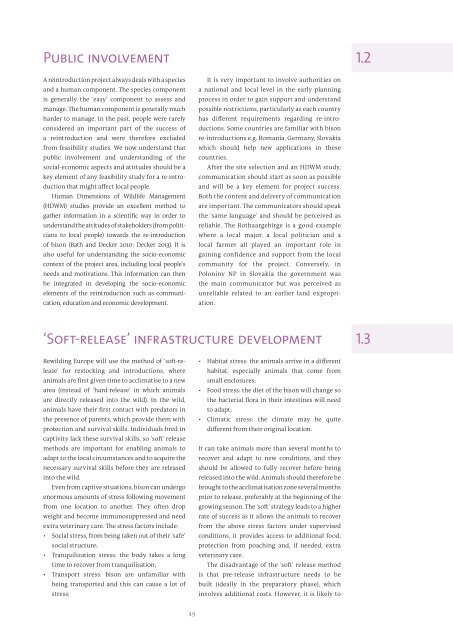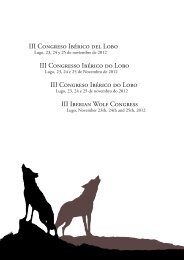Bison-Rewilding-Plan-2014
Bison-Rewilding-Plan-2014
Bison-Rewilding-Plan-2014
- No tags were found...
Create successful ePaper yourself
Turn your PDF publications into a flip-book with our unique Google optimized e-Paper software.
Public involvement1.2A reintroduction project always deals with a speciesand a human component. The species componentis generally the ‘easy’ component to assess andmanage. The human component is generally muchharder to manage. In the past, people were rarelyconsidered an important part of the success ofa reintroduction and were therefore excludedfrom feasibility studies. We now understand thatpublic involvement and understanding of thesocial-economic aspects and attitudes should be akey element of any feasibility study for a re-introductionthat might affect local people.Human Dimensions of Wildlife Management(HDWM) studies provide an excellent method togather information in a scientific way in order tounderstand the attitudes of stakeholders (from politiciansto local people) towards the re-introductionof bison (Bath and Decker 2010; Decker 2013). It isalso useful for understanding the socio-economiccontext of the project area, including local people’sneeds and motivations. This information can thenbe integrated in developing the socio-economicelements of the reintroduction such as communication,education and economic development.It is very important to involve authorities ona national and local level in the early planningprocess in order to gain support and understandpossible restrictions, particularly as each countryhas different requirements regarding re-introductions.Some countries are familiar with bisonre-introductions e.g. Romania, Germany, Slovakiawhich should help new applications in thesecountries.After the site selection and an HDWM study,communication should start as soon as possibleand will be a key element for project success.Both the content and delivery of communicationare important. The communicators should speakthe ‘same language’ and should be perceived asreliable. The Rothaargebirge is a good examplewhere a local major, a local politician and alocal farmer all played an important role ingaining confidence and support from the localcommunity for the project. Conversely, inPoloniny NP in Slovakia the government wasthe main communicator but was perceived asunreliable related to an earlier land expropriation.‘Soft-release’ infrastructure development1.3<strong>Rewilding</strong> Europe will use the method of ‘soft-release’for restocking and introductions, whereanimals are first given time to acclimatise to a newarea (instead of ‘hard-release’ in which animalsare directly released into the wild). In the wild,animals have their first contact with predators inthe presence of parents, which provide them withprotection and survival skills. Individuals bred incaptivity lack these survival skills, so ‘soft’ releasemethods are important for enabling animals toadapt to the local circumstances and to acquire thenecessary survival skills before they are releasedinto the wild.Even from captive situations, bison can undergoenormous amounts of stress following movementfrom one location to another. They often dropweight and become immunosuppressed and needextra veterinary care. The stress factors include:• Social stress, from being taken out of their ‘safe’social structure;• Tranquilization stress: the body takes a longtime to recover from tranquilisation;• Transport stress: bison are unfamiliar withbeing transported and this can cause a lot ofstress;• Habitat stress: the animals arrive in a differenthabitat, especially animals that come fromsmall enclosures;• Food stress: the diet of the bison will change sothe bacterial flora in their intestines will needto adapt;• Climatic stress: the climate may be quitedifferent from their original location.It can take animals more than several months torecover and adapt to new conditions, and theyshould be allowed to fully recover before beingreleased into the wild. Animals should therefore bebrought to the acclimatisation zone several monthsprior to release, preferably at the beginning of thegrowing season. The ‘soft’ strategy leads to a higherrate of success as it allows the animals to recoverfrom the above stress factors under supervisedconditions, it provides access to additional food,protection from poaching and, if needed, extraveterinary care.The disadvantage of the ‘soft’ release methodis that pre-release infrastructure needs to bebuilt (ideally in the preparatory phase), whichinvolves additional costs. However, it is likely to49



